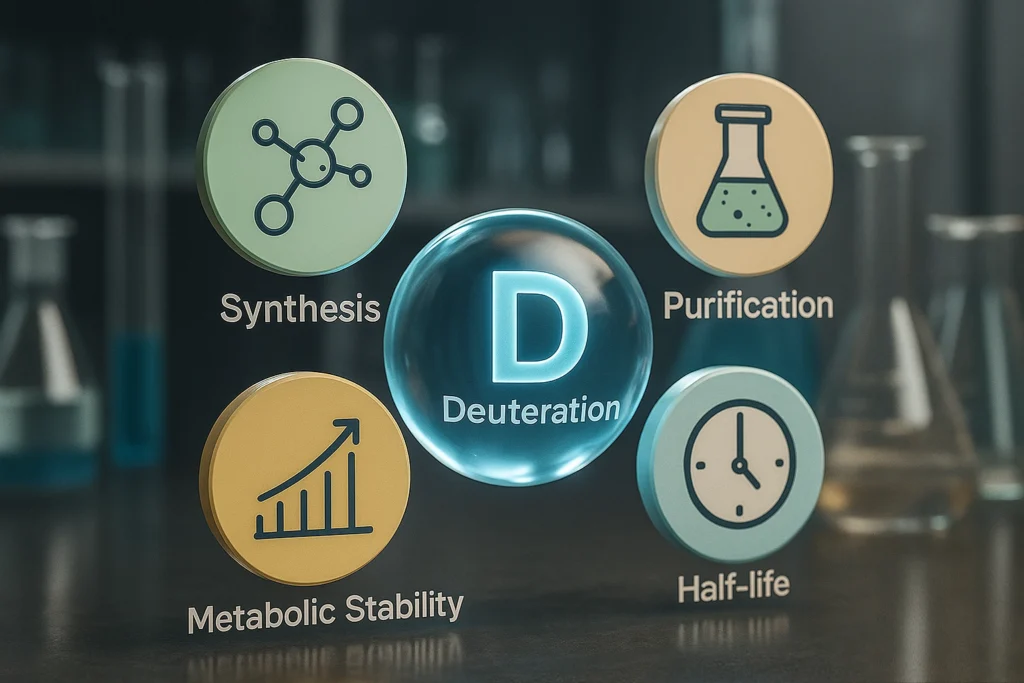Deuterium (D) is a heavy stable isotope of hydrogen (H) and is an increasingly utilised strategic modification to improve drug performance (Di Martino, 2023). The substitution of deuterium isotope for hydrogen offers improved pharmacokinetic performance by extending drug half-life against metabolism by virtue of the kinetic isotope effect, without significantly impacting other aspects of drug performance. This opinion piece highlights some of the challenges and opportunities that deuterium presents to medicinal chemist in the development and manufacture of deuterated drug products.
Isotopologues are molecules which are chemically identical but differ in their isotopic composition (i.e. for water, the hydrogen and deuterium isotopologues comprise H2O, D2O and HDO). Within this definition of isotopologues are isotopomers, which contain the same number of isotopes but at different locations within the molecule (i.e. for mono-deuterated propane, CH3-CH2-CH2D and CH3-CHD-CH3 are isotopomers).

While clinical relevance of a potential deuterium switch is highlighted by the existence of many compounds under clinical investigation, the use of deuterium has recently expanded beyond the improvement of already marketed drugs to become an integral part of the drug discovery process. Application of isotopologues and isotopomers in drug design offer new performance potential by:
- improving metabolic stability
- lowered drug dosing for patients
- lowered drug dosing frequency for patients
- reduction in potential toxic metabolic by-product(s)
- retention of pharmacological activity despite isotope substitution
- Mitigating patent cliff and strengthening commercial IP
- A streamlined regulatory process towards approval of a deuterated drug
However, for drug substance manufacture, deuteration can pose some specific additional difficulties, particularly when regio- and/or stereoselective control is required, as is often the case for chiral drug products. A common strategy for medicinal chemists faced with delivering chirally configured drugs, is to utilise easier synthetic routes to prepare the corresponding racemate. Subsequent isolation of a single enantiomer from the racemate relies on Down Stream Processing (DSP) approaches such as chiral chromatographic techniques.
Whilst this approach is often effective (albeit costly and negatively impacting process mass intensity) for separation of enantiomers, the corresponding separation of isotopologues and isotopomers is significantly more demanding. Hydrogen/deuterium isotopomers differ only by a tiny variation in mass rendering any discriminating interaction with chiral stationary phases especially challenging. To date we are not aware of any successful examples of mixed isotopomer separation being successfully demonstrated by chiral chromatography. Consequently, this commonly used technique cannot be employed as a readily available method to support preparation of single isotopomer products from a corresponding mixture.
The complexity of small molecule drugs, particularly at late stage or final API stages, creates significant potential for cross reactivity, lack of control and unwanted conversions for the medicinal chemist. Typically this manufacturing alteration becomes a formidable task for synthetic chemistry to provide targeted deuteration substitution at desired sites of registered late-stage intermediates and/or final API.
The exquisite selectivity of biocatalysis and biotransformation offers an attractive, cost-effective means to overcome such limitations of isotopomer separation or synthesis, by providing the excellent stereo- and regio control in deuteration that synthetic chemistry cannot easily provide. The controlled asymmetric synthesis enabled by biocatalysis avoids the need and wastage incurred in subsequent chiral chromatographic separations. Accordingly, enzyme-mediated synthesis enables precision based conversions that can provide late stage intermediate or API substrate deuterations.
Having spent 25 years innovating the use of enzymes to optimize small molecule manufacturing routes, I would love to hear your thoughts and opinions on this topic. I’m also happy to discuss any challenges you are currently facing in drug substance development—and whether this approach could offer a solution.
Reference: Di Martino RMC, Maxwell BD, Pirali T. Deuterium in drug discovery: progress, opportunities and challenges. Nat Rev Drug Discov. 2023 Jul;22(7):562-584. doi: 10.1038/s41573-023-00703-8. Epub 2023 Jun 5. PMID: 37277503; PMCID: PMC10241557